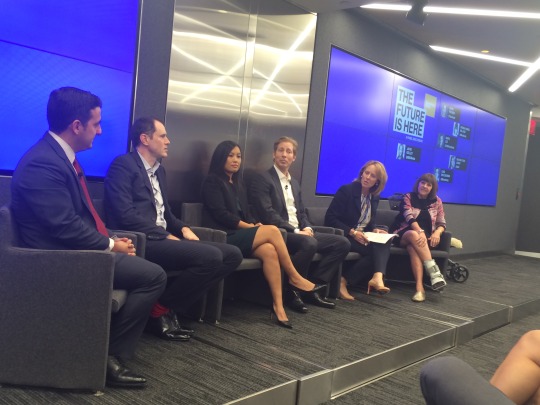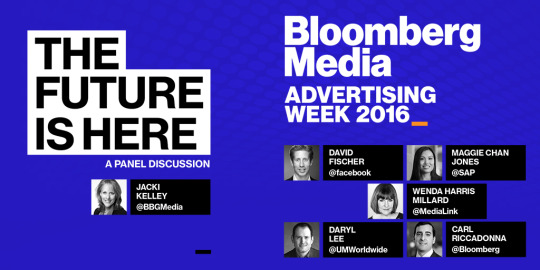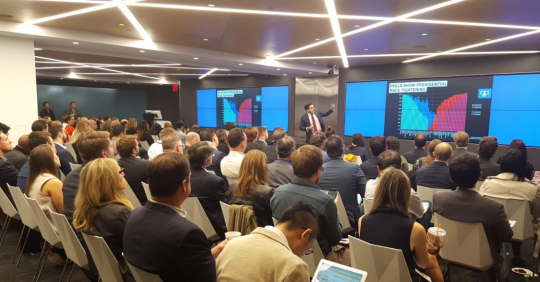September 29, 2016
The digital era has put consumers firmly in control of their experiences, with more choice in what, when and how they buy than ever. It’s also given businesses more ways than ever to understand what consumers want.
That’s causing radical shifts in the way marketers, ad agencies and media companies think about everything from storytelling to technology to company culture. And it’s not just the advertising industry that’s adapting to the new consumer power; global economies are, too.

Bloomberg Media’s Global Leadership Breakfast kicks off Advertising Week New York, September 26th, 2016. Panelists included L-R: Carl Riccadonna, Chief U.S. Economist, Bloomberg Intelligence; Daryl Lee, Global CEO, UM; Maggie Chan Jones, CMO, SAP; David Fischer, VP, Business and Marketing Partnerships, Facebook; Jacki Kelley, COO, Bloomberg Media; Wenda Harris Millard, President and COO, MediaLink.
That new world was the focus of Advertising Week New York’s lead-off event on September 26, a Global Leadership Breakfast hosted by Bloomberg Media and moderated by Bloomberg Media COO Jacki Kelley. The session began with a macro-economic briefing by Bloomberg Intelligence Chief U.S. Economist Carl Riccadonna, which provided a global backdrop for discussion among Kelley, Riccadonna and leaders David Fischer of Facebook, Wenda Harris Millard of MediaLink, Daryl Lee of UM and Maggie Chan Jones of SAP.

In the US, consumer spending contributes 70% of the economy and dominates growth, Riccadonna said. That spending is in turn driven by confidence, job creation and income growth. “We’ve been stuck in a very sluggish economic story,” he added, but that’s beginning to change as employment rises. That puts more pressure on employers to increase pay – and that, said Riccadonna, “will put a tail wind to household income growth, and a tail wind to consumer spending.”
Those increasingly confident shoppers are no longer passive recipients of advertising messages – or editorial content, for that matter. “When you’re moving from planned, calculated, focus-group tested messages to a place where you’re actually interacting in real time – that’s really powerful and promising for people and for brands,” said Facebook’s David Fischer.
“What’s changed is the ability marketers have to gain real insight about their consumers.” – Wenda Harris Millard, President and COO, MediaLink
There’s an opportunity to engage more deeply with audiences, through the increased personalization offered by new technologies. “What’s changed significantly in the last few years is the ability marketers have to gain real insight about their consumers,” added MediaLink’s Wenda Harris Millard. Insights gleaned from data help marketers plan and react quickly and confidently.

Bloomberg Intelligence Chief U.S. Economist Carl Riccadonna offers a macro-economic briefing at Advertising Week New York.
That development has also created new imperatives for brands and agencies. “The digital revolution has made us all data stewards, but also required us to be content literate,” said UM Global CEO Daryl Lee. “Real time responsiveness to consumer need requires you to have a data capability to understand what consumers want, to have a receptivity capability to understand how consumers are reacting, and to have a content capability to respond to that.”
Traditional advertising industry business models are being turned upside down, because responding to people goes beyond content for companies; it gets to the heart of active interactions. Building “branded behaviors that attract people to your message versus interrupt people is an obvious thing. But it’s hard to do,” Lee said. “We’ve created a whole industry around interruption, which has been extremely effective in selling products. But it’s going to have to change.”
“We’ve created a whole industry around interruption, which has been extremely effective. But it’s going to have to change.” – Daryl Lee, Global CEO, UM
In this evolving world, creating company cultures that are diverse and inclusive is essential, the panelists agreed. In SAP’s marketing group, “50% of my leadership team are women, and 50% are also ethnic minorities – I want to mimic what our customer base looks like,” said CMO Maggie Chan Jones. With customers in 190 different countries, representing a wealth of viewpoints on her team is a powerful way to be consumer-centric.
Being attuned to the way people live and work also means embracing mobile. Fischer pointed out that “the average person in the US with a smartphone checks it 150x per day,” but there’s still a gap between how the public uses mobile and how marketers do. Content, experiences and opportunities need to be presented to consumers in mobile-first ways – personalized through data, and grounded in the art of connecting emotionally.
“We’re finally seeing the convergence we talked about – it’s happening.” – Wenda Harris Millard, President and COO, MediaLink
Doing so “requires us to not think like advertisers,” said Lee, adding: “We have mobile-first platforms at scale – but to me the question is, how do we get to mobile-first storytelling, that actually delivers on, ‘you’re really listening to me as a person?’ ”
Added Millard: “I think we’re moving back to center – we’re understanding that we need to marry data and technology with art. We’re finally seeing the convergence we talked about over 20 years ago – it’s happening. There are no answers, it’s not going to stop. What I would say is, go with it.”
– Jen Robinson | September 28, 2016